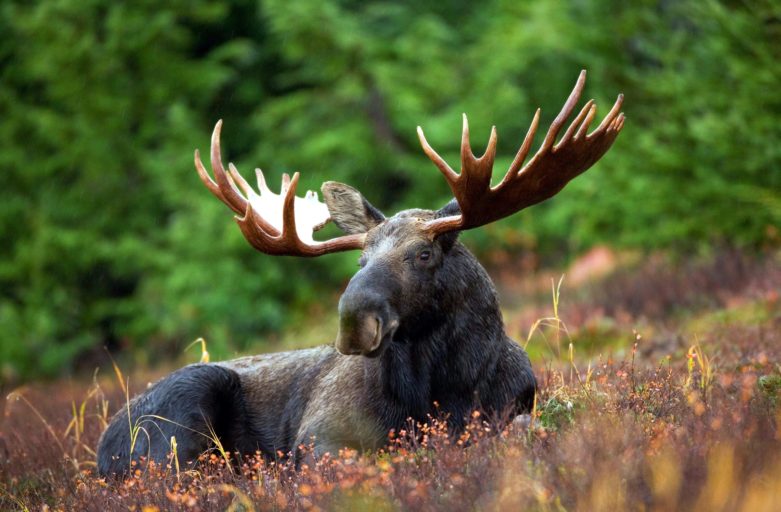By: Chief Rod Googoo
It is important that Nova Scotians are fully informed about the traditional harvest that we are undertaking in Cape Breton Highlands National Park. Intermittently, over the next few weeks, selected Mi’kmaw harvesters will be using traditional knowledge and customs to harvest a portion of moose within a small designated area of the Park, in partnership with Parks Canada. Parks Canada will then continue their study and monitoring of the area to see if the traditional harvest achieved the desired effect of creating a sustainable, balanced eco-system that will ultimately provide for a proper moose population, as well as a healthy environment for all species of animals and plants that make the Highlands so unique. This is a onetime event and further projects will be entertained, if required.
The Mi’kmaq of Nova Scotia, through the Assembly, Unama’ki Institute of Natural Resources (UINR), and Kwilmu’kw Maw-klusuaqn Negotiation Office (KMKNO) have been working in partnership with Parks Canada and Nova Scotia Department of Natural Resources for over a decade on moose management. Each government has brought its own expertise and resources to the process to ensure a healthy and sustainable moose population. This particular project, with Parks Canada, has been developed after years of study and discussion.
It is extremely important to understand, at the outset, that the Mi’kmaq of Nova Scotia have constitutionally protected Aboriginal and Treaty Rights to harvest moose in the Highlands. The Supreme Court and various courts in Nova Scotia, have long established this fact. We have been exercising our Constitutional rights to harvest moose for over 25 years. The courts have also been clear that Mi’kmaq have a Constitutional first priority over all other users, subject to conservation, to harvest for food, social and ceremonial purposes. This has also been a legal fact for over 25 years.
It is vital that the eco-system remains in balance. Moose are an important element of that eco-system, as are all animals and plants. However, balance requires proper control of invasive species. This can be done through predation by animals such as wolves, or, in the Mi’kmaw view, through harvest. Many comments around this issue show a Euro-centric point of view that places humans outside the eco-system; Mi’kmaq understand that we are an integral part as our actions, if properly governed by traditional ethics and guidelines, are a vital component to maintaining balance of the eco-system.
Therefore, when Parks Canada indicated that they were contemplating a “cull”, Mi’kmaq expressed two concerns.
First, it must be said that Mi’kmaq have not previously attempted to harvest inside the Park, even though there were no conservation issues that would limit our Constitutional rights. Why have we not harvested in the Park minus an agreed to management plan? We know that Parks are special to all Canadians and as such, if a harvest did take place it should be done in collaboration with Parks Canada to ensure eco-system management, and be based on Mi’kmaw and Parks concerns over the health of the moose and their surroundings. For Mi’kmaq, stewardship of the eco-system is just as much a right as harvesting is.
Second, the harvest of moose is a sacred, cultural event for Mi’kmaq. When the Assembly published its guidelines in 2009 respecting the proper ethics for a Mi’kmaw harvester, the document began with the story of Tiam’s (Moose) Promise. In time immemorial, the moose offered itself up to the Mi’kmaq so that we could survive. We, in turn, had to promise that we would respect the body and soul of moose and use it only for cultural and physical survival. This is a fundamental Mi’kmaw law. When we heard that a “cull” might take place, it was impossible for us to support the idea of killing animals and leaving them to rot in the field, or to have them hunted for sport. It was imperative that if animals are taken, then they are to be harvested with proper ceremony and rites, and that they give themselves up for people’s sustenance.
Based on both our Constitutional and cultural position, we entered into an Agreement with Parks in 2012 that, among other things, ensured that Mi’kmaq would have the first opportunity to partner with Parks in the event that a “cull” was deemed necessary in any national park in Nova Scotia.
Mi’kmaq have heard that this is “not fair”. I would remind Nova Scotians that for decades, governments and citizens refused to honour our Treaties; For decades, Mi’kmaq were denied access to traditional resources while others exploited them; Mi’kmaq were forcibly removed from our traditional lands next to these resources and moved to reserves; Mi’kmaq children were taken to residential school to alienate them from our cultural laws and practices– this was not fair. Notwithstanding the fact that Mi’kmaq have the legal priority to engage in this project, we feel that our involvement in this project is just and fair in reconciling Mi’kmaw rights and responsibilities with Parks’ objectives and obligations.
This project is an initial step toward reconciling Mi’kmaw harvest rights and stewardship responsibilities. We hope that it is a precedent for the way forward. Backlash is inevitable, which is unfortunate. The Assembly is convinced that partnership and collaboration, not confrontation and anger, are the only ways to truly reach reconciliation. During this project, we have reached out to non-Native partners to work with us in the future. Many were interested, but their concerns over the backlash made it difficult. Our harvesters and communities have lived through confrontation and intimidation, so we fully understand their concerns. Despite the things that have been said by some, we will continue to build bridges with those from the non-Native community who wish to work with us.
Rod Googoo is the Chief of the We’koqma’q Mi’kmaw Community in Cape Breton and is the Lead Chief of the Lands, Wildlife, and Forestry Portfolios for the Assembly of Nova Scotia Mi’kmaq Chiefs. The Assembly is comprised of all 13 Mi’kmaw Chiefs in Nova Scotia.

